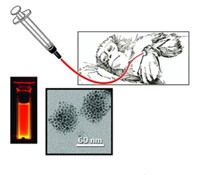Advertisement
Grab your lab coat. Let's get started
Welcome!
Welcome!
Create an account below to get 6 C&EN articles per month, receive newsletters and more - all free.
It seems this is your first time logging in online. Please enter the following information to continue.
As an ACS member you automatically get access to this site. All we need is few more details to create your reading experience.
Not you? Sign in with a different account.
Not you? Sign in with a different account.
ERROR 1
ERROR 1
ERROR 2
ERROR 2
ERROR 2
ERROR 2
ERROR 2
Password and Confirm password must match.
If you have an ACS member number, please enter it here so we can link this account to your membership. (optional)
ERROR 2
ACS values your privacy. By submitting your information, you are gaining access to C&EN and subscribing to our weekly newsletter. We use the information you provide to make your reading experience better, and we will never sell your data to third party members.
Materials
For Nanoparticles, Size Does Matter
Nanotoxicology: Precise control of nanoparticle dimensions shows that size and shape of cerium dioxide nanomaterials influences their ability to damage cells
by Katharine Sanderson
May 14, 2012

A library of nanoparticles made to exact dimensions has revealed that particle size and shape affects their toxicity in cells (ACS Nano, DOI: 10.1021/nn3012114).
As part of a larger effort to devise safety tests for nanomaterials, Jeffrey Zink of the University of California, Los Angeles and his colleagues have made libraries of nanorods and wires of cerium dioxide. For applications in electronics and catalysis, manufacturers usually make nanoscale cerium dioxide into spheres, which aren’t thought to be toxic. But these products sometimes contain other shapes. Zink and his team wanted to determine whether shape made a difference.
Using a standard synthesis method in water, Zink’s team carefully controlled the temperature, pH, and ions present to make a range of nanorods and wires with precisely controlled ratios of length to diameter, called the aspect ratio. Using this library of eight materials, they tested the toxicity of the nanoparticles in human leukemia cells, a line commonly used in inflammation studies.
Cells treated with the short rods died at the same rate as untreated cells, indicating to the researchers that the small particles weren’t toxic. But bigger particles–those greater than 495 nm long and 9.5 nm wide–triggered some cells to activate an inflammatory protein, and killed the 35% of the cells.
The test is the first to examine the role of aspect ratio in cell toxicity, the team says. Using these results coupled with other data the group is gathering, including data on particles’ electronic properties (ACS Nano, DOI: 10.1021/nn3010087), could help researchers predict toxicology and risk for nanomaterials, says study coauthor Andre Nel.




Join the conversation
Contact the reporter
Submit a Letter to the Editor for publication
Engage with us on Twitter